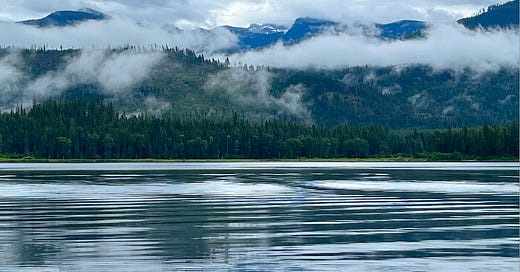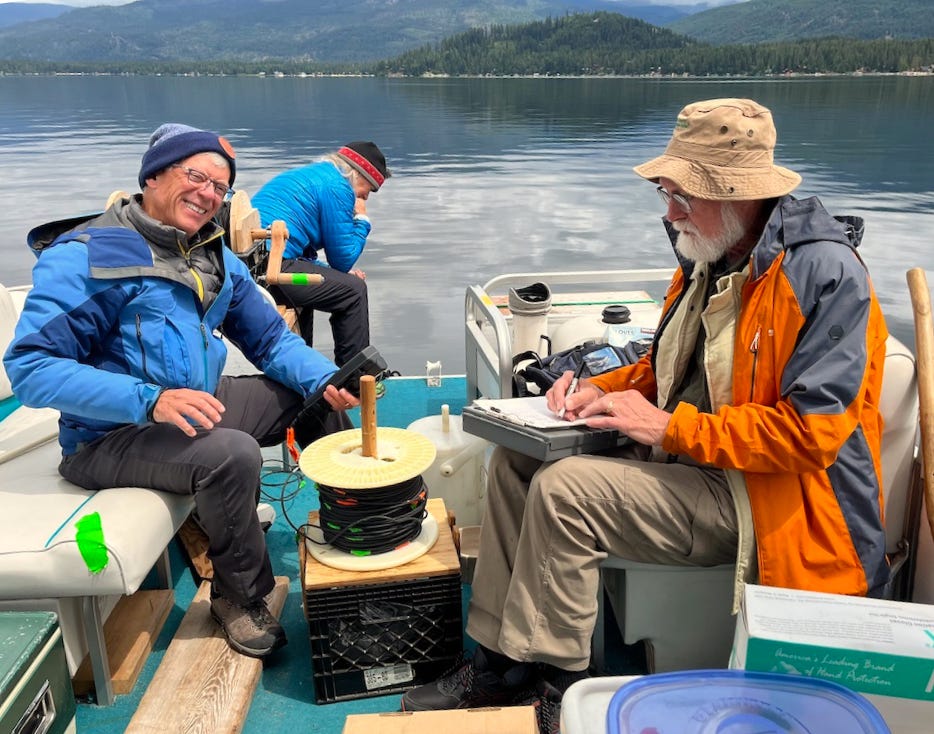Wednesday morning, east shore, Priest Lake
Aboard with the Selkirk Conservation Alliance
It’s not my greatest weakness but I have a hard time in boats, especially smaller boats. I’m a swimmer, not a boater, and when I’m in a boat (unless it’s an ocean liner) I fight the urge to jump overboard. It’s the sort of thing that can mark a person as peculiar, or anti-social.
Bald eagle in a streamside tree near upper Priest Lake
That wasn’t a problem the past couple days, on Priest Lake, where I joined Stan Miller and a handful of other members of the Selkirk Conservation Alliance aboard a pontoon boat. When we set off early Tuesday morning the temperature was in the forties, the wind was gusting, white caps forming, and veils of rain were falling on the Selkirk mountains on both sides of the lake. I was wearing a thick woolen cap and two coats. My swim gear was in a suitcase miles away. The only way I was going in the water is if I fell or was pushed in.
Jon Quinn-Hurst at the helm of the Alliance’s sampling vessel
Stan invited me to this excursion and it wasn’t a hard sell. As much as the prospect of being on Priest Lake the first day of summer (yesterday) it was an opportunity to spend some field time with Stan, who is one of the region’s foremost water quality experts. He’s a human encyclopedia and I’m eager to learn. I say “field time” but it was all water time except for some creeks we sampled on Monday and Wednesday.
Priest Lake is a canary in our ecological coal mine for a few reasons. It’s the crown jewel of inland Northwest lakes, tucked against an edge of the Newport fault, with 6,000 to 7,000 foot high peaks rising abruptly from the east shore. Because of the low nutrient load in the lake, the water is stunningly clear. Huckleberries grow along roadsides, and the fluting calls of Hermit thrushes pierce the lakeside forest.
Who wouldn’t want to live here? The answer to that question is offered by the string of cabins and expensive homes that rim the shoreline, all but encircling the 20-mile long lake. Not everybody is worried about loving Priest Lake to death, but that’s certainly a concern, as is the concern about the effects of logging the forests on both sides of the lake. On the west side of the lake the woods are primarily managed by the U.S. Forest Service and, on the east side, by the Idaho Department of Lands which actively cuts trees to produce revenues for the state’s schools.
SCA president Curt Wickre (left), Stan Miller (right) and Janis Houghton, lowering a temperature/dissolved oxygen probe at the rear.
Perhaps the biggest threat to Priest Lake is global climate change. With air temperatures rising, the lake water temperature also rises, and two years ago the lake water that feeds the Priest River—that flow southward from the lake to the Pend Oreille River—was so warm it caused a major fish kill of whitefish and trout in the river.
Some years I don’t get to Priest Lake, but most years I have and the best times have been camping and swimming and kayaking with my family. For a place that is draped in upscale real estate, the public access and amenities are still first rate.
That said, I’d only seen a small part of the lake from the water (kayaking out of Coolin’, at the south end) until this week. The opportunity to get aboard the Selkirk Conservation Alliance’s water testing vessel was a chance to experience the lake from the water. And that’s what we did over two days—going from Coolin all the way up to Upper Priest Lake—gathering water samples for lab analysis and testing water column temperatures.
Female merganser in “the Thoroughfare” between the upper and lower lakes
We got off to a rough start on Tuesday because the weather was so nasty. But things calmed down just enough to manage the misery and gather the samples.
One of the things I couldn’t help but notice is that everyone on board was a board member of the Alliance, including the board’s president Curt Wickre, who was regularly lying on his stomach at the bow of the boat doing the visibility tests or spooling the temperature/dissolved oxygen probe. Curt shared time on the bow with Janis Houghton, a board member with a degree in biology who grew up in Spokane but now lives on the west side of the lake. Jon Quinn-Hurst, a therapist who lives near Priest River, was our captain, and Stan was stationed in the middle of it all busily recording the instrument data in log books and supervising the sample collection, labeling and storage. On Wednesday, Jim Lea, a retired neurologist was aboard as we visited Upper Priest Lake where he and Curt were collecting data and upgrading a stream sensor along Trapper Creek near the north end of the upper lake.
I’ve worked with a handful of non-profit environmental and public health groups in my career and I don’t remember a working expedition consisting entirely of board members. They welcomed me with ease and humor. I came away feeling all the better about humanity and our chances of making positive differences because of their spirits and attitudes. In some ways the spray, rain and cold headwinds were just a metaphor for the whole process of modern citizenship and stewardship. It is not for the faint of heart.
I wanted to end with a touch of wonder. I’d been hearing about Upper Priest Lake for the past 35 years or so. But I’d never been up there before yesterday.
Streamside at “the Thoroughfare” to Upper Priest Lake
There’s a winding, shallow strait (called “the Thoroughfare”) that connects Upper Priest Lake to Priest Lake proper. For me it was the most compelling part of the journey. The streamsides are so lush they instantly brought to mind the jungle lakes and streams in the Panamanian rainforests near where I grew up. The water is so clear we could see scores of mature trout hunting where Caribou Creek enters the Thoroughfare as it flows from the upper lake. It’s been months since I’ve been in such a wild and beautiful place and it’s hard to ask a camera to capture more than a small sample of it.
Being there in person was worth the wait.
—tjc










